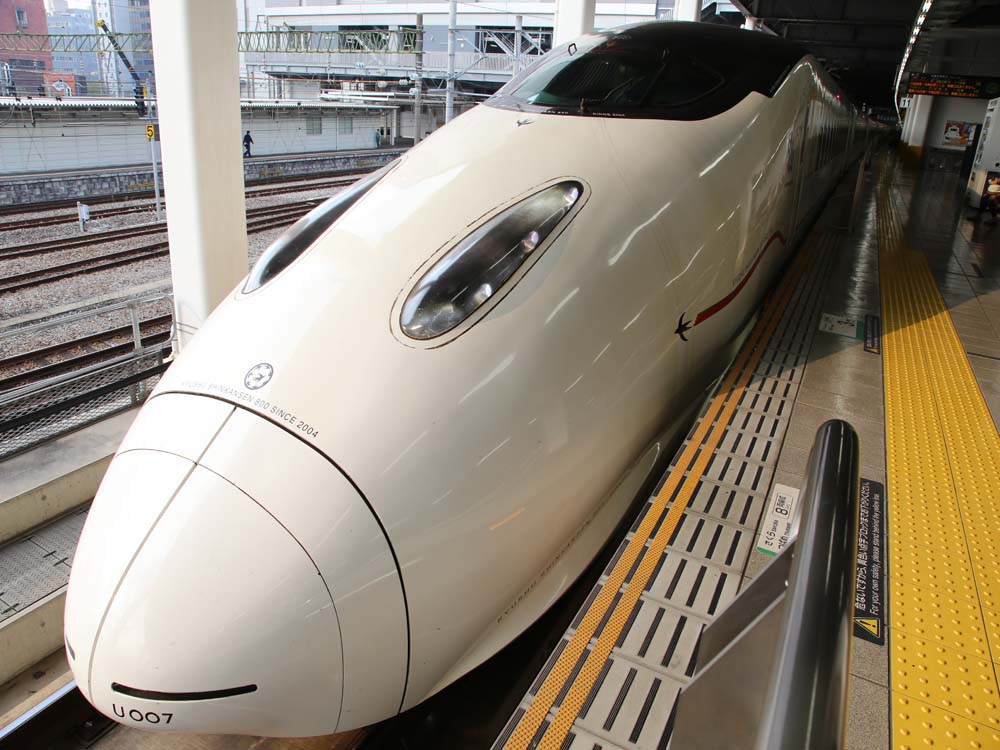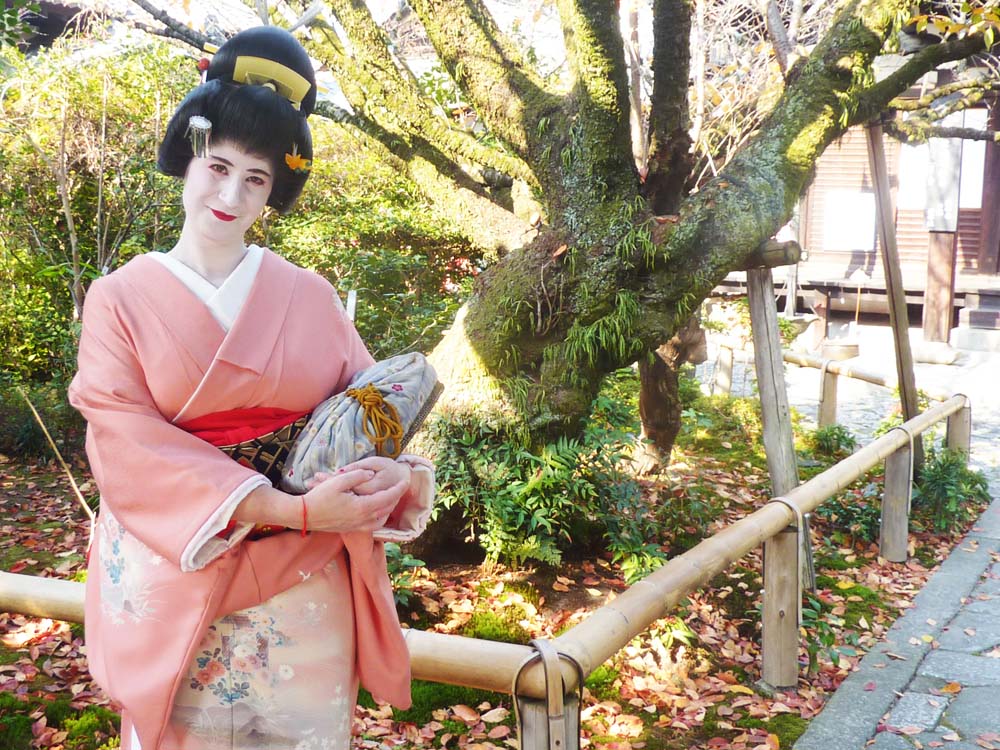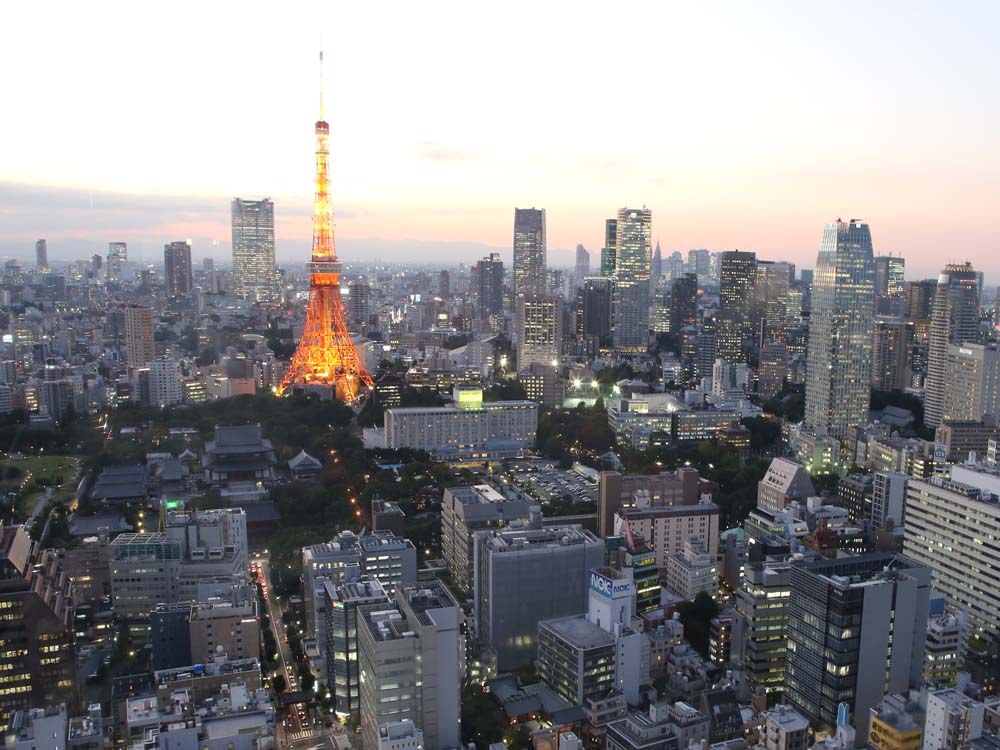The Big Trip: Japan, Found in Translation
Weird fish, immaculately dressed geishas, golden temples and nude bathing – Laura Millar takes a bullet train ride across Japan

Weird fish, immaculately dressed geishas, golden temples and nude bathing – Laura Millar takes a bullet train ride across Japan
Weird fish, immaculately dressed geishas, golden temples and nude bathing – Laura Millar takes a bullet train ride across Japan
Well, this would never happen in Yo! Sushi. Sitting in a swish dining room in Fukuoka, I warily eye up a platter of raw, white, translucent fish that looks like a display of unwrapped condoms - and I'm nervous. Should the chef who prepared it have been distracted, this prized delicacy could be a murder weapon... Yes, I'm about to tuck into an eight-course fugu tasting menu at the two-Michelin-star Hakata Izumi restaurant – and, potential death aside, it's a veritable bargain at around £60, including drinks.
Fugu, the Japanese name for pufferfish, is famous for its frightening level of toxicity, with inners that contain a poison 200 times more powerful than cyanide. Despite this, and perhaps because of it, it's a highly regarded dish here. Since 2000, 23 people in Japan have died after eating fugu, and I pray I’m not its next victim. Naohiro Miyatake, the genial head chef, assures me he’s been specialising in fugu preparation for over 45 years, and explains that such fatalities result from people rashly preparing their own catch at home.

Bullet for you: a shinkansen ready to depart Fukuoka station ©Yasufumi Nishi/JNTO
Even so, I feel a strange frisson as I try my first nibble – although, frankly, its taste would be fairly bland but for the accompanying soy and chilli sauce. And what a shame my untimely demise would be, because Fukuoka turns out be to a engaging gateway to a host of exciting eating, sightseeing and cultural opportunities. Set on the island of Kyushu, to the west of mainland Japan, this smart city can now be reached on a new route flying from the UK with KLM, and my plan is to board Japan’s famously efficient shinkansen (bullet train), call into some of its most interesting cities, then fly back from Tokyo, 677 miles east.
Japan, if you’ve never been, is probably a blur in your consciousness of Blade Runneresque neon, kimono-clad women, Hello Kitty cuteness, cherry blossom, sushi, sake, and samurai. Suffice to say you will probably encounter all of these – plus temples galore. In Kyoto, my next stop, I learn that this former imperial capital has a whopping 1,600 of them. After about five they tend to blur into one, but there are two absolute standouts. The Golden Pavilion (Kinkaku-Ji) is one of the most over-the-top retirement villas you’ll ever see, covered entirely in gold leaf on the order of the rich Shogun who had it built for when he withdrew from military life in 1397. The other don’t-miss is Kiyomizu-Dera, an imposing multi-roofed structure with a pillared veranda which juts over a hillside offering a stunning view of the city below.
Celebrity news, beauty, fashion advice, and fascinating features, delivered straight to your inbox!

Temple of delight: Kiyomizu-Dera in Kyoto ©JNTO
Kyoto is also famous for the traditional female entertainers known as geisha. Here they’re called ‘geiko’, only attaining that status after four years’ apprenticeship – learning crucial skills such as flower arranging, ritual tea ceremonies, and how to play musical instruments such as the lute-like shamisen. Generally you can only be in their company if you’ve paid to attend a performance. The theatre at Gion Corner is an inexpensive way to do this, at about £16 per ticket, but private performances are more authentic, and, of course, expensive: some companies offer this with a tour and traditional meal, for around £200.
My brilliant Kyoto guide, Mie, arranges a visit to an ochiya – a lodging house in which apprentices (‘maiko’) live with a more senior geiko. It sounds like boarding school, only worse. Maiko aren’t allowed to use the internet or go to chains like Starbucks or McDonald's, and only see their family around twice a year. They have hardly any spare time as almost every minute is spent doing lessons and chores. Many give up during the first year, but others are determined to make it to graduation.
Observing Tomi Tsuyu, a 17 year-old in her first year, I understand the appeal. Her dramatic white and red make-up, elaborate hairstyle and delicate silk kimono are strikingly beautiful, while she carries herself with a grace and poise I could never emulate. She effortlessly demonstrates a complicated dance, and a very long and precise way of pouring tea, then warbles a rather lovely but incomprehensible song. Compared to the garish pop-cartoon colours of the teenage girls you see on the streets (particularly in Tokyo’s famous Harajuku shopping district), Tomi is elegant, lady-like and ever-so-unattainable-looking. I immediately want to be like her, and book a ‘maiko makeover’ at a studio near the Kiyomizu-Dera temple.

Turning Japanese: Laura enjoys a maiko makeover in Kyoto
This entails a 25-minute application of make-up, including heavy black eyeliner, plus white foundation covering my face right down to the base of my shoulders. I’m then dressed in a kimono – another 25-minute process which involves much draping, tying and belting. A very heavy black wig is placed on my head while I try to balance on a pair of traditional geta (raised wooden sandals). When it’s all done I can barely move. I manage to take some short, hobbling steps outside to a shrine to pose for photos, and immediately get mobbed by a throng of Japanese schoolgirls begging for selfies. Lady Gaga must feel like this every day...
Staying with my traditional theme, I board another train for the two-hour journey northwest to Kinosaki Onsen. Visiting onsen – or natural hot springs – is one of the country’s most popular pastimes. Kinosaki has seven, and is an almost comically old school-looking town. A river runs through its centre, lined with weeping willows which flank ancient, curved stone bridges. I check into an old fashioned ryokan, or inn, where there are formal rules to observe. These include wearing only slippers indoors, donning a yukata (cotton robe) while on the premises, and sleeping on a futon on the floor; I can get on board with all that.

Winter palace: dip into the rituals of Japanese bathing at Kinosaki Onsen ©Toyooka City/JNTO
The regulations for onsen bathing are even more strict, but essentially there’s just one: nudity. A whole lot of naked, unclothed nudity. Oh well, when in Kinosaki… The experience is meant to be very good for the skin, and it's nice to sit contemplatively in the steaming hot water (men and women bathe separately). Then, after a delicious, traditional, eight-course, formal kaiseki dinner, I hit the ryokan’s karaoke bar. Of this experience I can only say that if you haven’t seen a middle-aged, tipsy, besuited salaryman belting out 'Living on a Prayer', you ain't lived.
The next morning, I bid farewell to my gracious hosts. Politeness rules in Japan, and by now I’ve almost emptied the box of business cards I brought along. I’ve just about got the knack of bowing, too, thanks to an initial teach-in from Mie. A bow at a 15° – or a short bob of the head – is shorthand for ‘sorry!’ or ‘thanks'. A lower 30° bow says ‘thank you very much’, or ‘thanks for coming’ – even train attendants do this, after walking through every carriage. My favourite is the 45° bow, where you bend over double. It’s used a lot by politicians and CEOs to apologise for wrongdoings (which happens as much as it does in the UK, apparently), as well as a sign of deep respect to your boss or elders. (I do like the idea of seeing someone like Jeremy Clarkson, say, forced to prostrate himself after his latest faux pas in a foreign country).
On my sixth day I push on south for Osaka, which swiftly becomes my new favourite city. For a start it’s one of the best places for food in the world. And roaming around the lively Dotonbori district after dark is where all those Blade Runner dreams come true. Tall buildings sport massive hoardings on which neon adverts blink and pulse, reflected surreally in the canal which flows through it. Here I manage to taste (read: stuff my face with) several cheap local specialities, including tako yaki, chopped-up octopus fried in batter (a million times more delicious than that sounds), and okonomiyaki, a savoury egg pancake you customize with different fillings.

Capital moment: The view from the World Trade Centre Building ©Yasufumi Nishi/JNTO
The standout meal, though, is at a kaiten, or conveyor belt, sushi restaurant (which were invented in Osaka) called Daiki Suisan. Every evening the chef demonstrates cutting up a huge, freshly-caught yellowfin tuna, which is then served as sushi or sashimi, along with dozens more melt-in-the-mouth fish dishes. The price is lower, and the quality higher, than you’d pay in the UK with most small plates around £1, and a hearty meal just £14.
The next day, another three hours gliding along on the shinkansen brings me to Tokyo, where I spend a last, leisurely afternoon on Omotesando Avenue, a wide, elegant boulevard lined with upmarket stores and designer boutiques. Here I buy presents to take home, and find a McDonald's selling a suspicious-looking black burger in honour of Hallowe’en. Obviously, I have to try it. And, obviously, it tastes very strange. (It’s the squid ink, apparently.) Oh Japan, how I love you, with your delicately presented food, your fondness for cartoon animals, your forensic attention to detail, your beautifully packaged products, your heated toilet seats, and your fatally poisonous fish...
Honestly, I can’t wait to go back.
Book now
KLM (klm.com) flies to Fukuoka, Osaka and Tokyo from 15 UK airports via Amsterdam, from £510 return. A Japan Rail Pass (jrpass.com) costs from £154 for seven days.
Recommended places to stay are the Grand Hyatt Fukuoka (from £168 with breakfast, fukuoka.grand.hyatt.com), Hyatt Regency Kyoto (£127, kyoto.regency.hyatt.com), Nishimuraya Honkan, Kinosaki Onsen (£348 for two half-board, kinosaki-spa.gr.jp), InterContinental Osaka (£166, intercontinental.com/osaka), and Andaz Tokyo (£327 with breakfast, andaztokyo.com).
Inside Japan Tours (01173 709751; insidejapantours.com) offers a nine-night 'Kyushu to Kanto' trip visiting all these cities from £1,125 per person based on two sharing, including accommodation, breakfast, transport and some activities, but not flights.
Japan (£17.99; Rough Guides) is a comprehensive guide. For more information visit seejapan.co.uk, yokanavi.com, kyoto.travel and gototokyo.org.
Thumbnail ©Toyama Prefectural Tourism Association/JNTO
Lead image: Fugu sashimi at Hakata Izumi, Fukuoka
The leading destination for fashion, beauty, shopping and finger-on-the-pulse views on the latest issues. Marie Claire's travel content helps you delight in discovering new destinations around the globe, offering a unique – and sometimes unchartered – travel experience. From new hotel openings to the destinations tipped to take over our travel calendars, this iconic name has it covered.